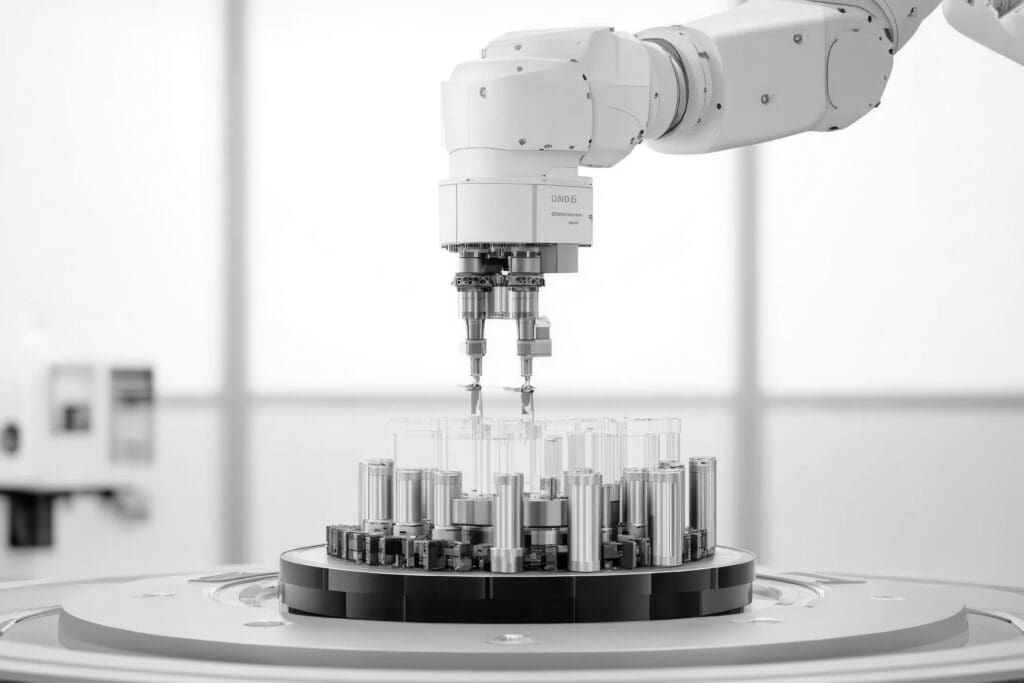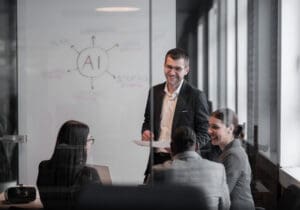How AI and digitalization are transforming the life sciences value chain
To stay competitive in a fast-moving market, life sciences companies must digitalize their entire value chain, from research and development to manufacturing and delivery. It’s all about becoming more agile, responding faster to market shifts, and bringing personalized products to patients more efficiently.
While the vision is clear, the reality is often a minefield of challenges such as outdated systems, siloed teams, and resistance to change. A successful smart factory transformation requires more than a technology roadmap. It calls for a grounded strategy that connects leadership goals with what is really happening on the factory floor.
At Eraneos, we have helped solve these same challenges in other highly regulated, complex manufacturing environments. The lessons we have learned and the results we have delivered, reveal a clear path forward for life sciences companies aiming to build smart factories that work in practice, not just on paper.
The vision behind Smart Factory transformation
Thomas Pung, Manager Smart Factory at Eraneos, specializes in helping companies bridge the gap between strategy and execution. He breaks down the core vision behind successful smart factory transformations, a fully connected value chain that drives real agility, speed, and responsiveness.
«The ideal vision is to digitalize the entire value chain, from commercial and supply chain functions to operations and leadership. This enables companies to respond faster, adapt more easily to market changes and deliver personalized products at speed. The goal is a setup where customer orders, feedback and data flow seamlessly across the organization, all the way back to research and development, creating a truly agile and insight-driven enterprise.»
Drawing on his extensive experience, Thomas shares insights from two complex transformation projects: one with a global manufacturing group facing deep internal resistance and legacy system challenges, and another with a high-tech manufacturer struggling to scale automation. These examples reveal how to overcome common roadblocks and what those lessons mean for the highly competitive life sciences industry.
Case 1: Breaking silos in a global manufacturing group
Challenge
While technology is a critical enabler of digitalization, it’s often people and politics that pose the biggest barriers. For many large manufacturers, transformation efforts are derailed not by tools but by siloed teams, misaligned leadership, and resistance to change. This was exactly the situation faced by one global manufacturing group.
Despite years of effort, the company had a long track record of failed digitalization attempts. Each factory operated as an independent island, with its own systems, workflows, and leadership priorities. A top-down initiative led by the CIO, designed to unify these operations under one system, had already failed. The core issue? It lacked buy-in from individual brands and departments, many of which viewed corporate-led transformation with scepticism.
Eraneos approach
Recognizing this, Eraneos took a radically different approach, built from the ground up. As Thomas Pung explains: “The owners didn’t trust outside consultants, and they even had their own internal group. So a traditional top-down approach was never going to work. When we entered, this was already the third major digitalization attempt. People were burnt out, the teams weren’t talking, and each site was still its own island.”
Instead of pushing a central mandate, Eraneos focused on one key daughter company, intentionally limiting political complexity and cultural friction. From there, we established a clear governance structure, brought in local champions, and built interdisciplinary teams on-site. We also recommended creating a Centre of Excellence for Digitization, now a lasting part of their strategy. This approach helped rebuild trust, generate early wins, and prove to leadership what was possible with the right structure in place.
Results
Even when teams were aligned, the technical landscape was a challenge. The company relied on over 100 disconnected, often homegrown “shadow IT” systems, which were critical to operations but difficult to maintain, impossible to scale, and incompatible with modern technologies.
By mapping the system landscape and creating a realistic, future-oriented roadmap, we helped them avoid costly missteps, including extending three major legacy systems that weren’t right for their future. That decision alone saved a seven-figure amount, plus the massive ongoing costs: roughly 100,000 annually for maintenance and 200’000–300’000 for each change request.
Beyond the financials, the transformation delivered greater transparency, reduced friction, and faster decision-making. Meetings were cut, miscommunication dropped, and teams gained confidence in their digital tools. The head of digital from the pilot company was promoted to lead digital transformation for the entire group.
Case 2: Scaling smart automation in a high-tech environment
Challenge
A high-tech manufacturer had successfully implemented smart automation in one department, but efforts to scale the solution further had stalled for over a year. The project was stuck due to a lack of focus, unclear ownership, and limited understanding of the existing complex environment.
Eraneos approach
Eraneos was brought in for its deep operational and technical knowledge of the systems and the organization. By quickly assessing the bottlenecks and realigning the project scope, we were able to restart momentum and deliver measurable results.
“The results from this kind of automation are dramatic,” says Thomas Pung. “We saw a workforce reduction from 10 people per shift down to just one. But the benefits go far beyond headcount.”
Automation has brought real-time transparency across the shop floor. As soon as a part is produced, sales and marketing teams are notified automatically. This allows them to proactively engage with customers, confirm deliveries, and strengthen trust, improving both customer satisfaction and the company’s reputation.
The project also had a strong impact on talent attraction and retention. As Thomas explains: “Young people saw that they wouldn’t be stuck doing repetitive manual tasks for eight hours a day. Instead, they’d be working in control rooms, managing processes through modern software. That completely changed how the company is perceived as an employer.”
The financial upside was just as compelling. The first department to adopt smart automation multiplied its revenue within six years, proving that the business case for scale was real and repeatable.
What this means for Life Sciences
These experiences from other complex manufacturing sectors offer a clear blueprint for the life sciences industry. Thomas Pung explains how the core challenges and solutions are directly applicable: “The parallels to life sciences are very strong. Of course, the regulatory compliance is completely different, that’s clear. But when you look at the core challenges, they are the same. Quality assurance, for example, is a top priority in both industries. We also see the same workforce challenges everywhere: skilled labor shortages, a lack of modern training, and resistance to automation. Then there are the supply chain vulnerabilities. We all learned from COVID about material shortages and logistic disruptions from global supply chains, and that’s a huge challenge. Finally, there’s the need for innovation. To meet today’s customization demands, you have to connect the entire product lifecycle, from R&D all the way through the value chain. When you achieve that, you can significantly improve key metrics like efficiency, productivity, and quality.”
Why Eraneos is your smart factory transformation partner
What sets Eraneos apart is our ability to act as a true end-to-end partner in digital transformation. We are not a large, one-size-fits-all consulting group. We operate as a boutique provider that combines high-level strategic thinking with hands-on, technical execution. Our team bridges the often wide gap between leadership and operations. We translate complex technical needs into clear business value for senior stakeholders — while also working closely with shop floor teams to implement change where it matters most. This integrated approach ensures that the strategy never gets lost in execution.
As Thomas explains: “We start by developing a digital strategy, then break it down into a smart factory strategy. Together with the client, we run assessments that result in an executable, prioritized roadmap. But we don’t stop at planning. In most cases, we’re also involved in implementation, whether that’s project management, AI, cybersecurity, or specific manufacturing technologies. That’s rare in our market, especially for a company of our size. We offer everything from one hand. That’s a big advantage — clients don’t have to explain things over and over to different suppliers.”
This end-to-end philosophy, from boardroom to shop floor, is what enables Eraneos to deliver real, measurable results.
- Mapped and optimized more than 100 disconnected systems, eliminating the need for costly, unsuitable legacy investments.
- Achieved seven-figure savings, avoiding approximately 100,000 in annual maintenance costs per system and 200,000–300,000 for each change request.
- Reduced workforce requirements from 10 to 1 per shift in automated operations, while multiplying revenue in the first automated department within six years.
To learn how our experts can support your smart factory journey, we invite you to connect with us.




